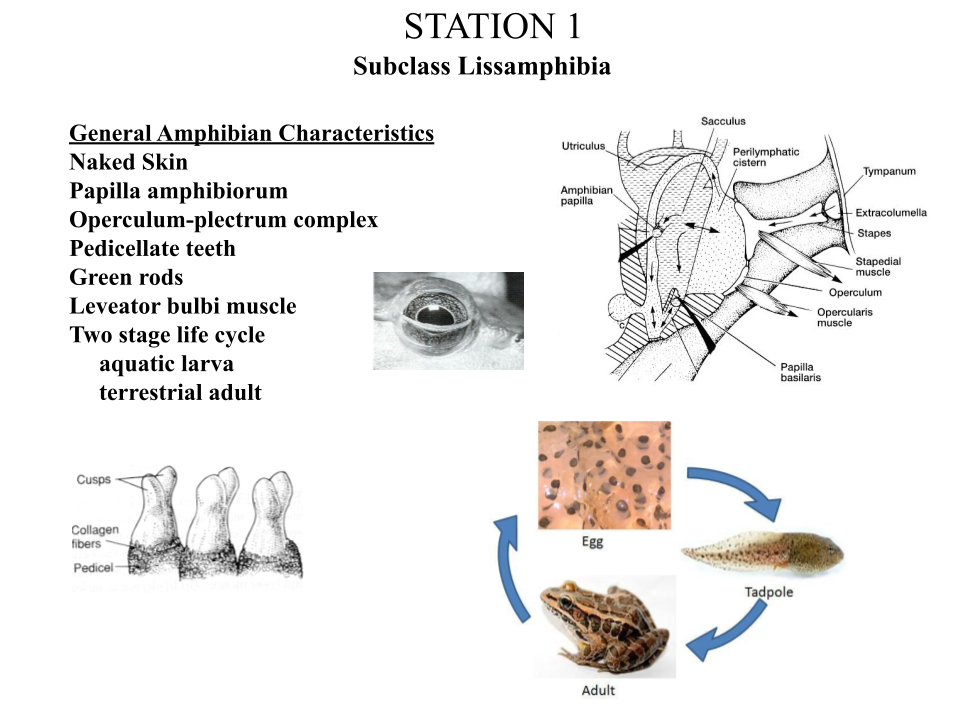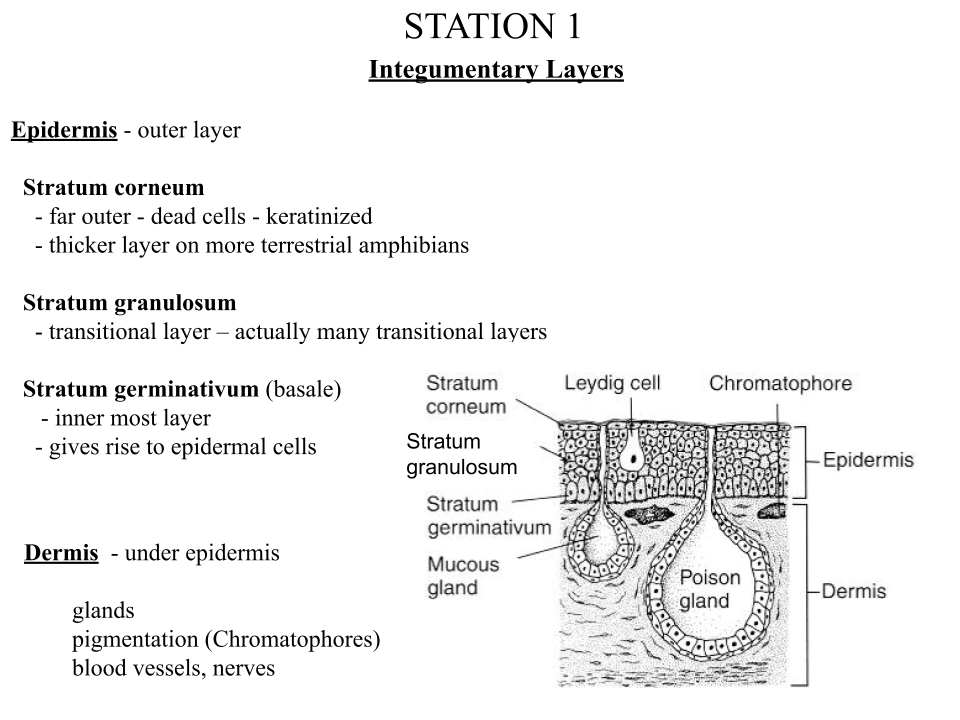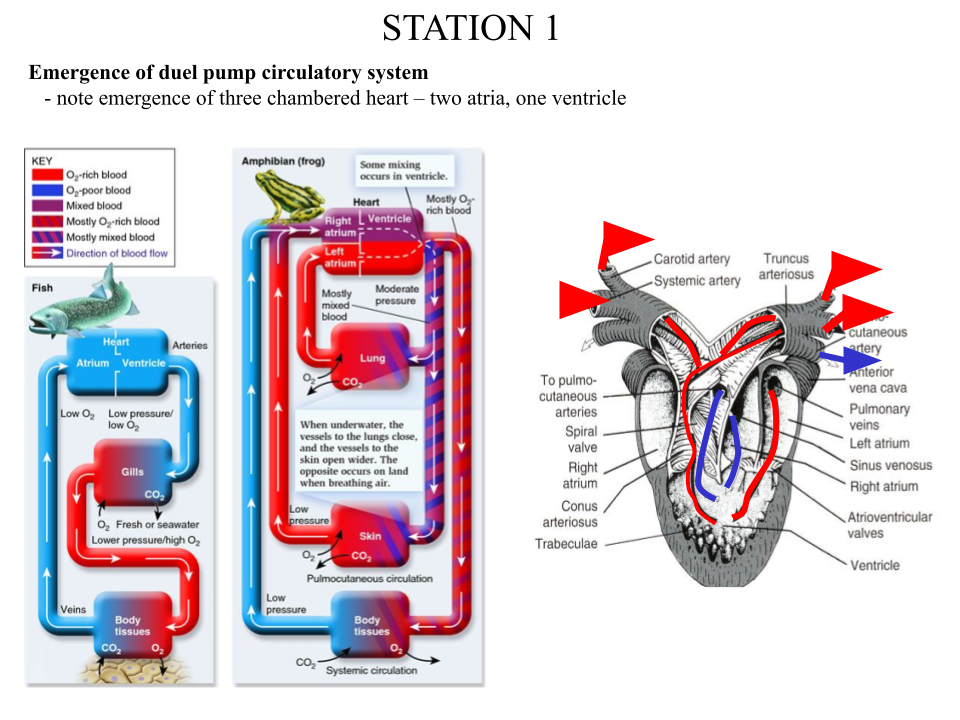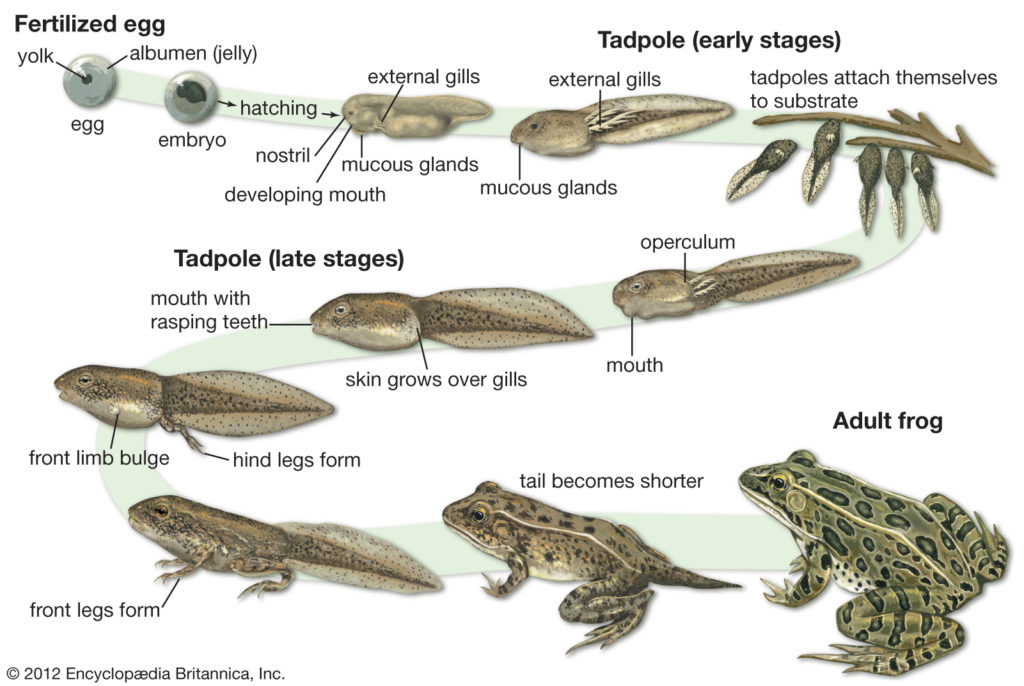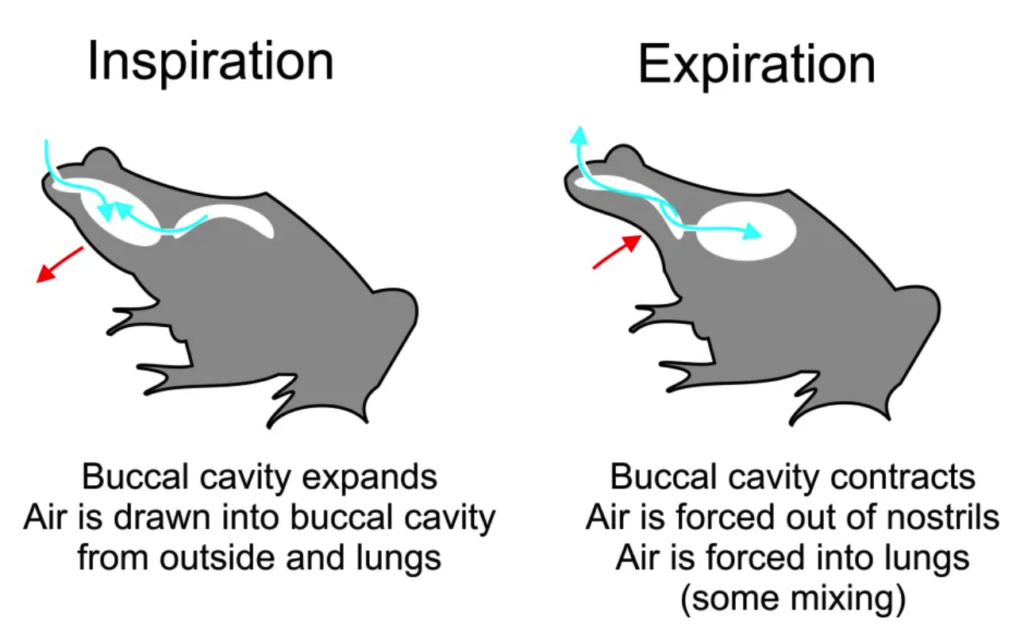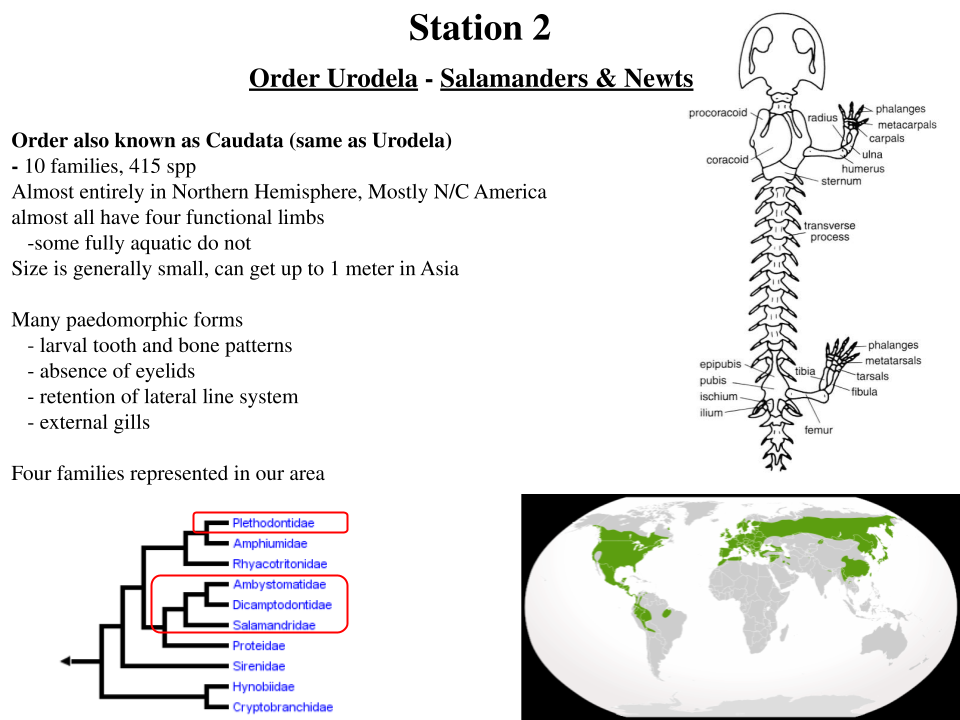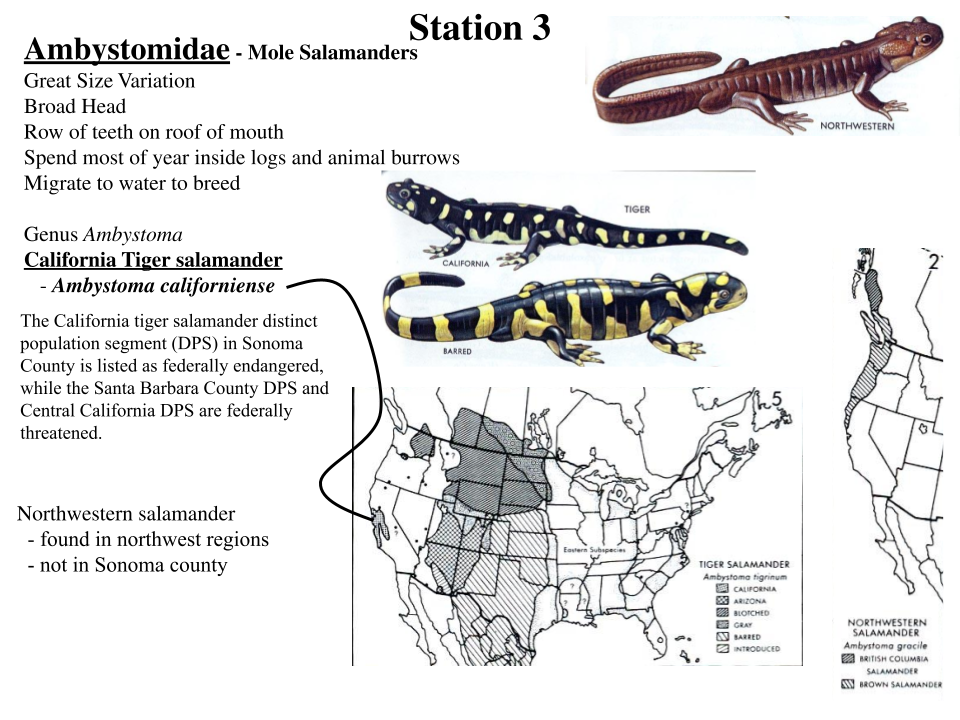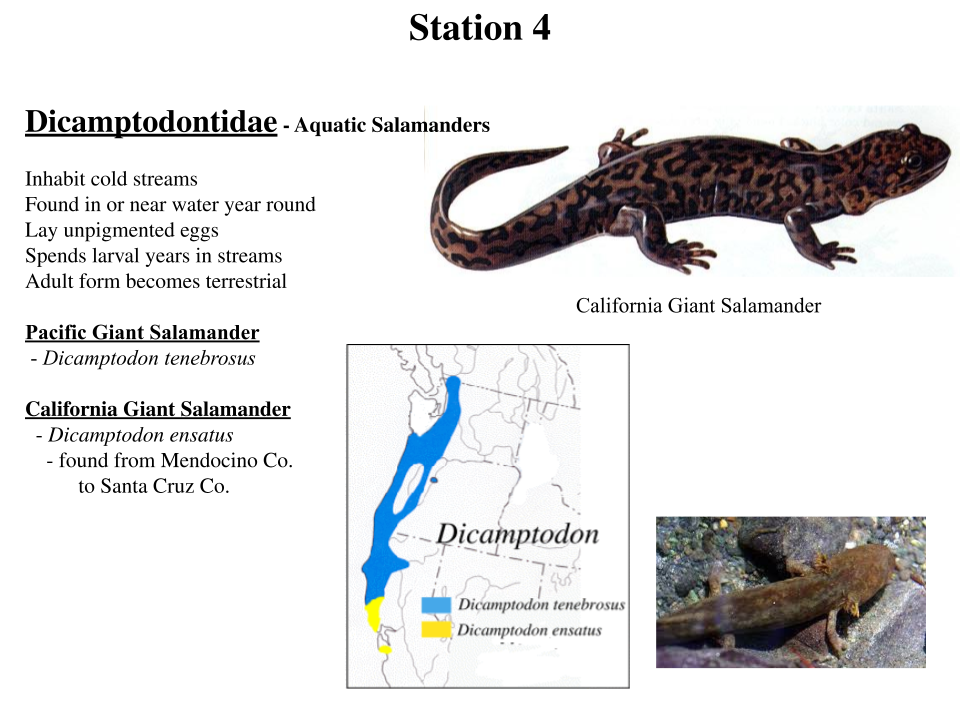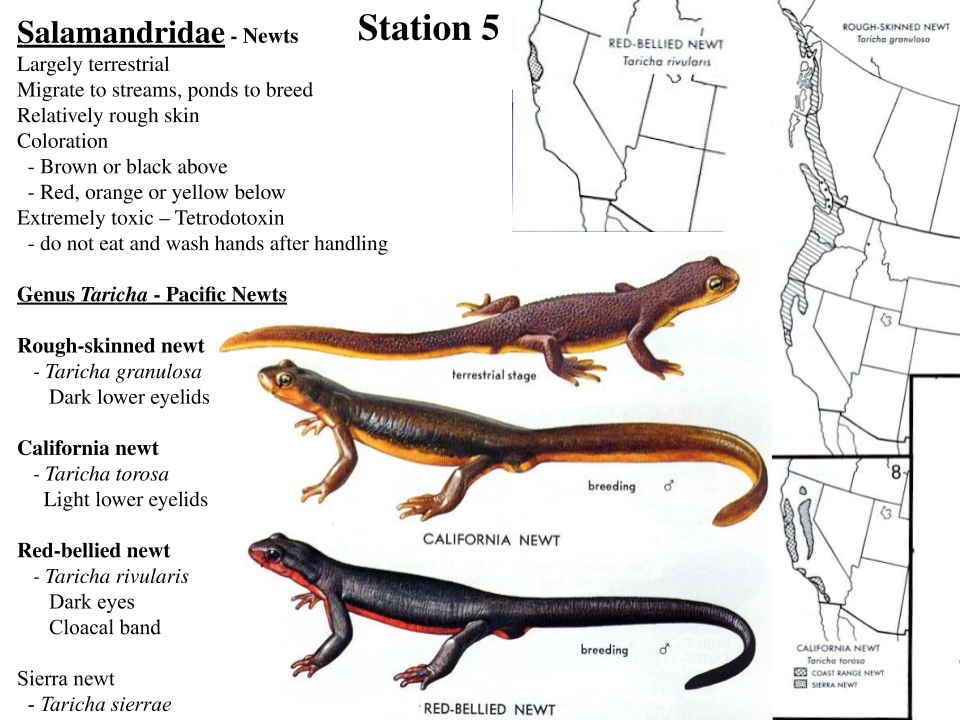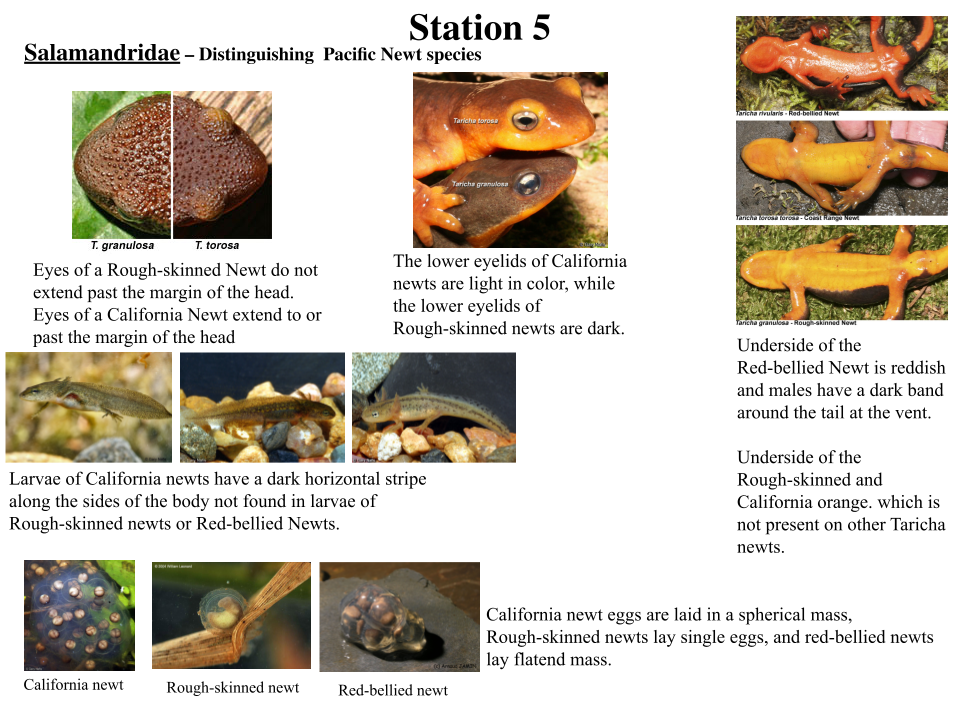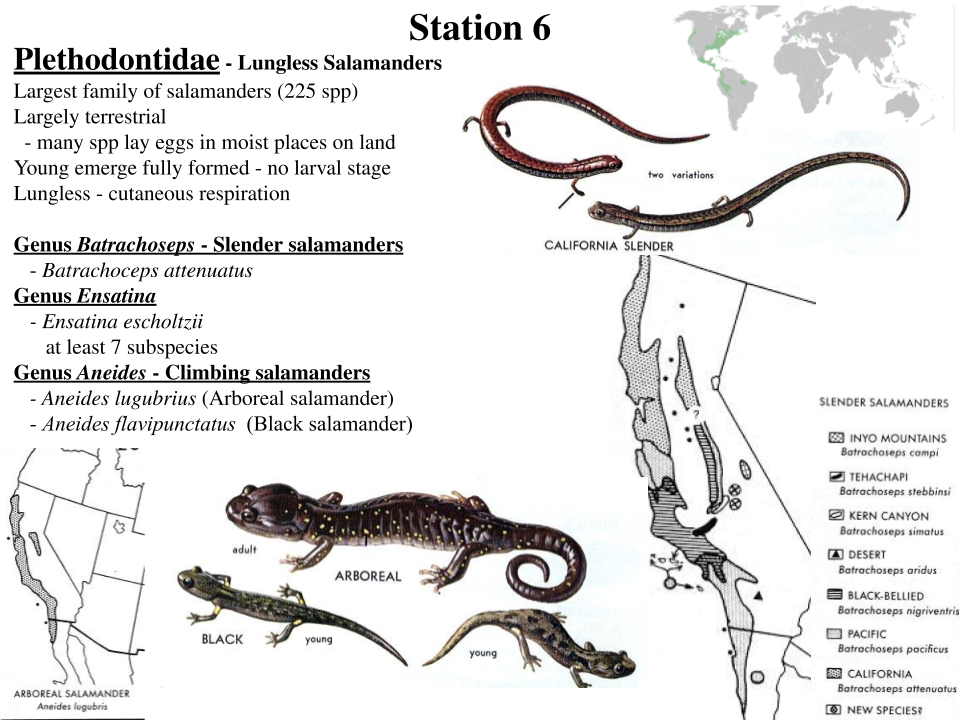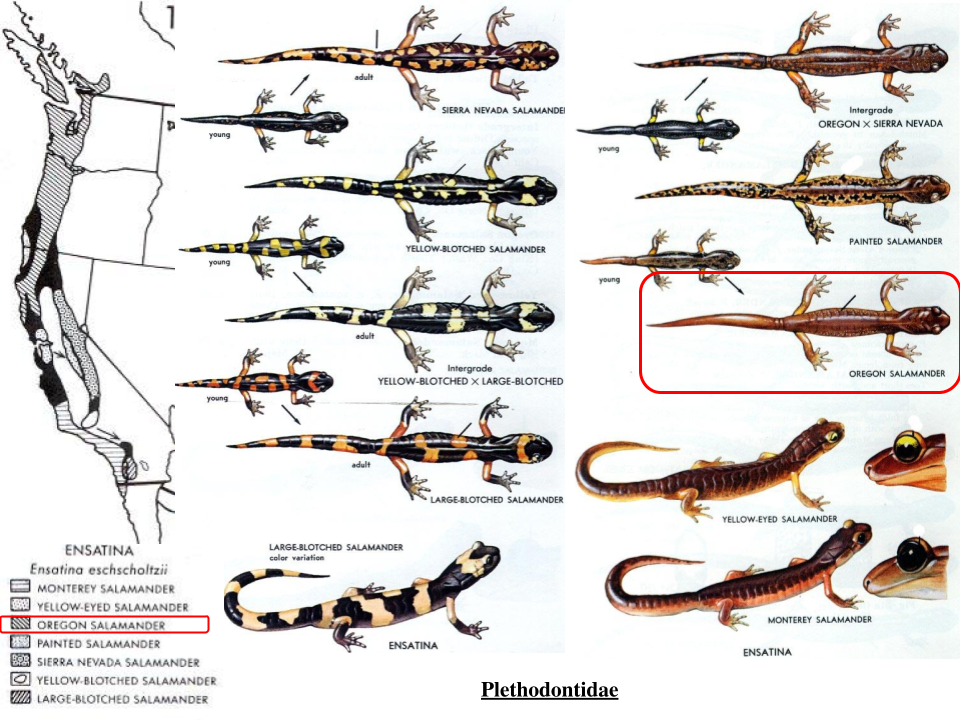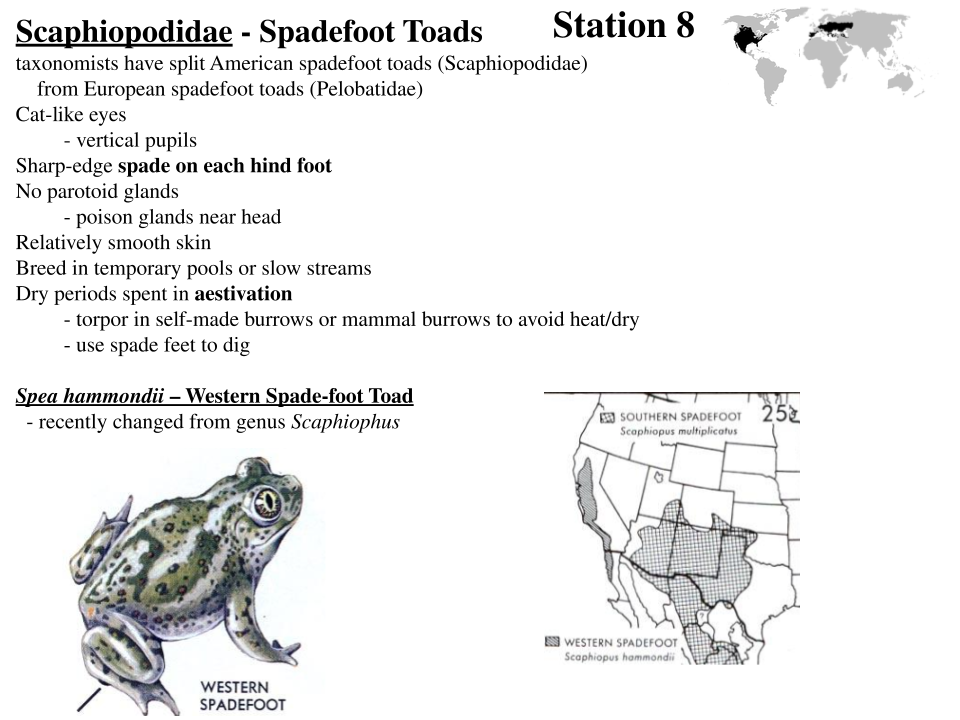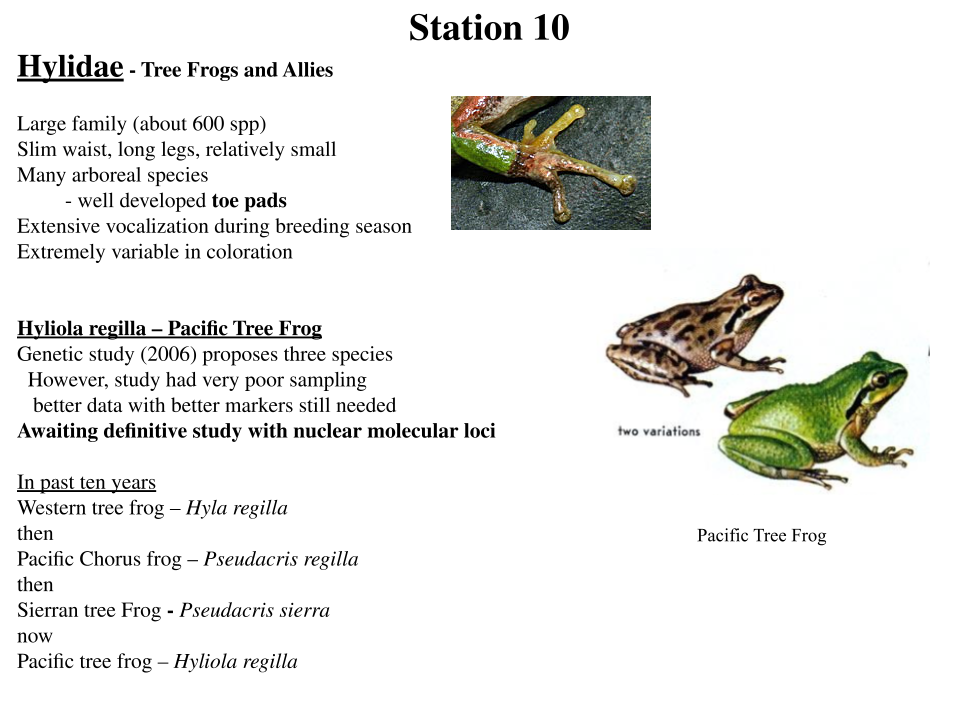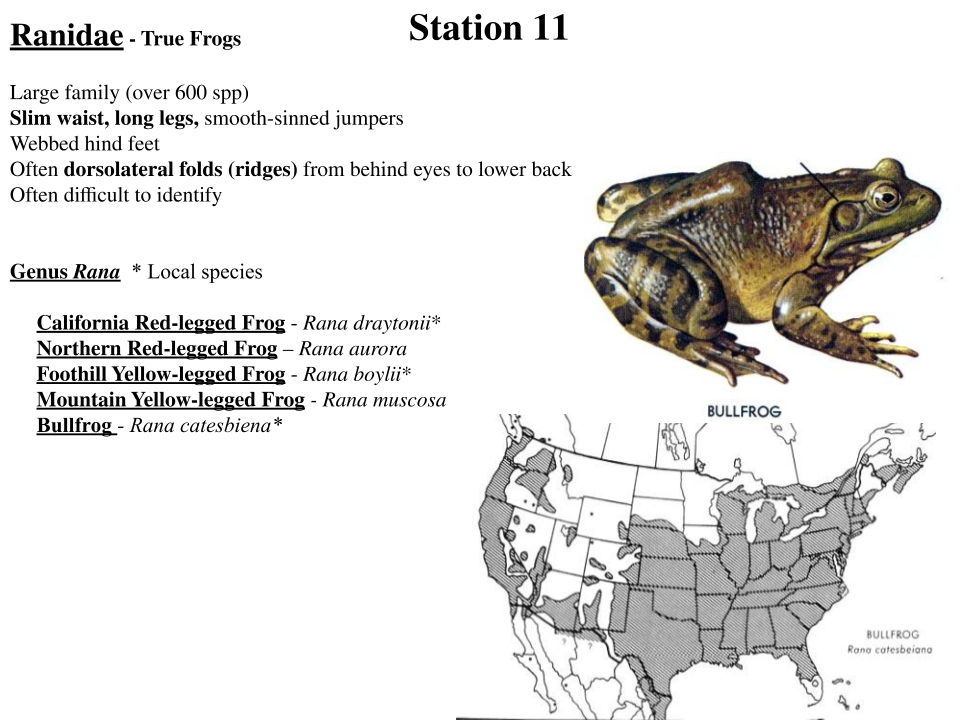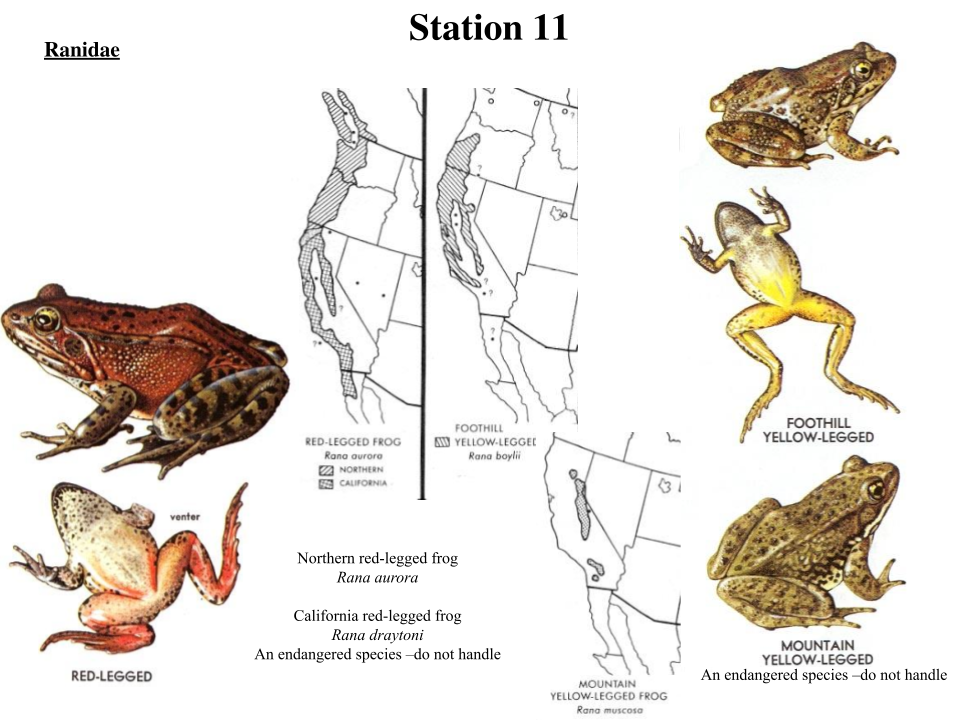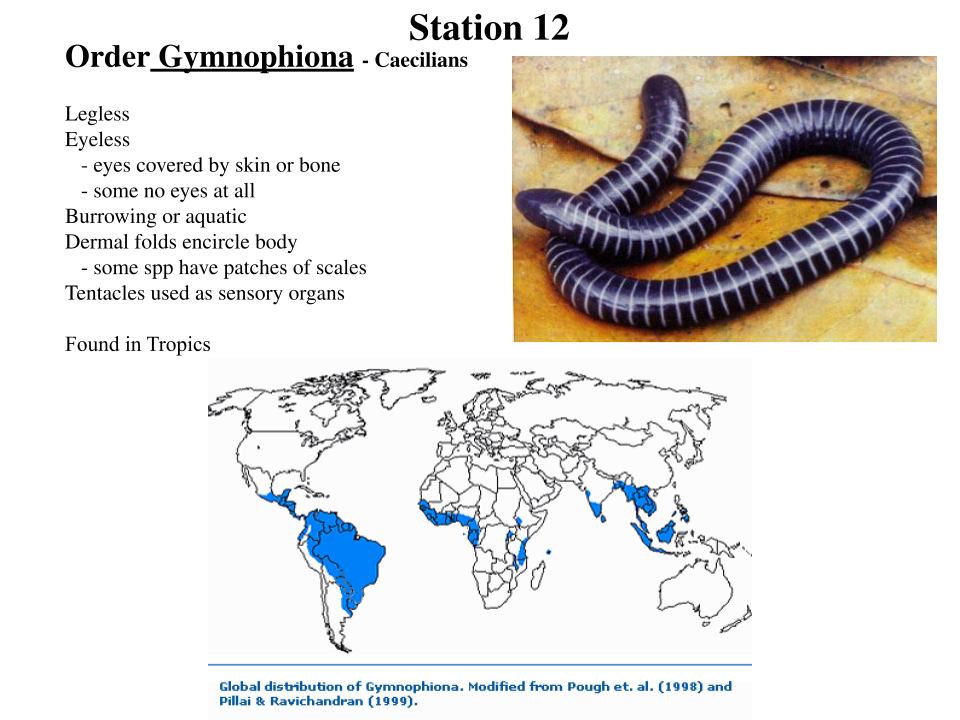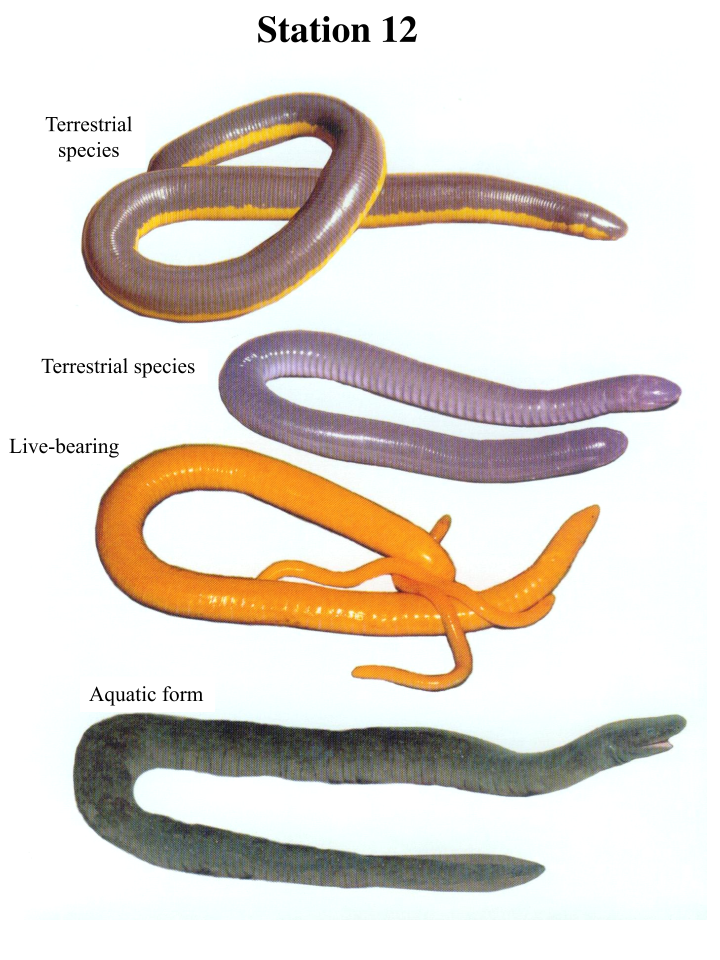Station 1: Subclass Lissamphibia
General Amphibian Characteristics
Naked Skin
Smooth, scaleless, permeable skin that allows gas exchange (both pulmonary and cutaneous respiration) and the absorption of water (most amphibians usually do not need to drink water). This makes them susceptible to skin infections like the one from the Batrachocytrium dendrobatidis fungus.
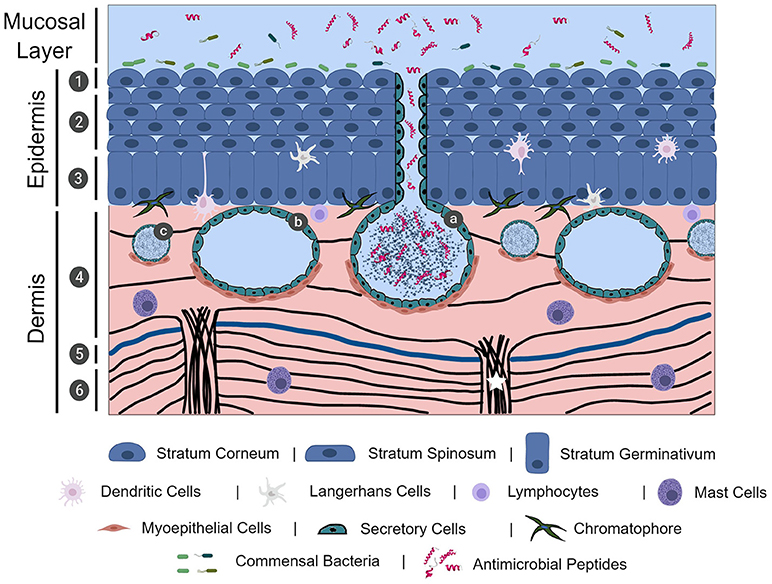
- Epidermis – outer layer
- Stratum corneum – far outer, keratinized dead cells. Thicker layer on more terrestrial amphibians
- Stratum granulosum – transitional layer (actually many transitional layers)
- Stratum germinativum (basale) – inner most layer that gives rise to epidermal cells
- Dermis – under epidermis
- Glands
- Pigmentation (Chromatophores)
- Blood vessels
- Nerves
Auditory Characteristics
- Papilla amphibiorum, a group of specialized cells in the inner ear which allow them to hear low frequency sounds.
- Stapes-operculum complex, which are in contact with the auditory capsule, improve reception of aerial and seismic waves.
Pedicellate teeth

Photo of pedicellate teeth, in which the crown and base are made of dentine and are separated by a narrow layer of uncalcified dentine. 

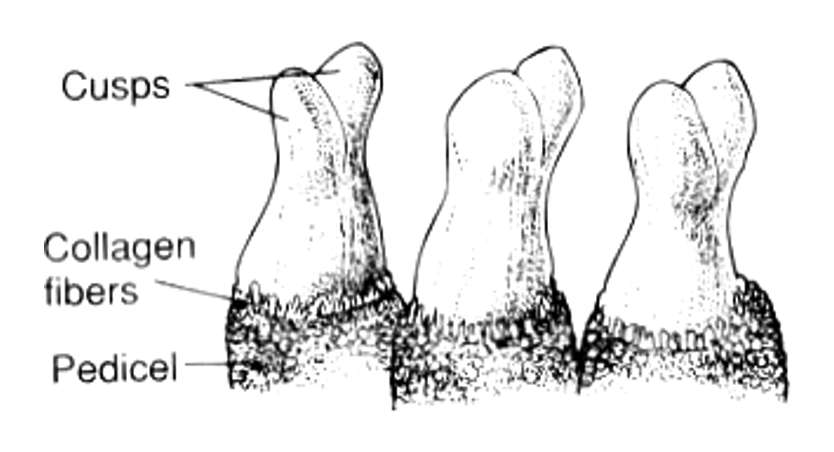
Visual Characteristics
- Presence of green rods in the visual cells (these allow the perception of more colors).
- Presence of a muscle elevator of the eye (called levator bulbi).
Two stage life cycle: aquatic larva & terrestrial adult
Circulatory and Respiratory Characteristics
- Emergence of duel pump circulatory system
- Three chambered heart – two atria, one ventricle
- Forced-pump ventilation system (their short ribs do not allow pulmonary ventilation, so they pump the air through their mouth).
Phylogenic Tree
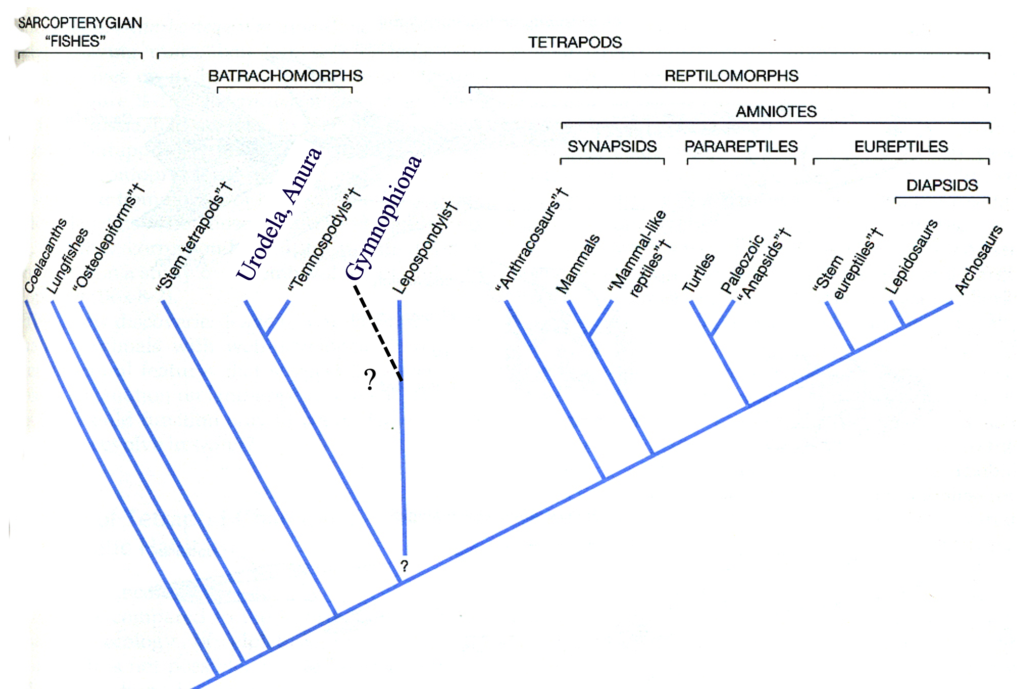
1. Referring to the photo below, draw and label the 3 layers of the epidermis.
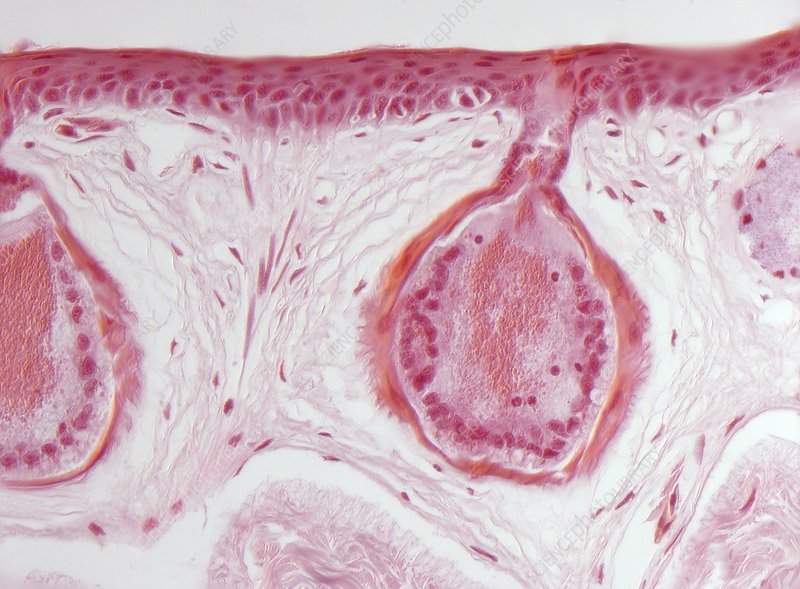
2. Describe 6 distinguishing amphibian characteristics.
3. Name the 3 modern Amphibian groups and the groups of fossil tetrapods that likely gave rise to each of these modern groups (see the phylogeny and/or your notes from last week).
4. What is the taxonomic name for all modern amphibians?
5. Draw a schematic that shows the generalized differences in the circulatory systems between fishes and amphibians.
6. Describe what happens to an amphibian eye during a blink.
7. Speculate about the evolutionary benefits of being able to hear low-frequency sounds.
Station 2: Order Urodela
Order Urodela (also known as Caudata): Salamanders & Newts
- 10 families, 415 spp
- Almost entirely in Northern Hemisphere, Mostly North and Central America
- Almost all have four functional limbs
- Some fully aquatic do not
- Size is generally small, can get up to 1 meter in Asia
- Many paedomorphic forms
- larval tooth and bone patterns
- absence of eyelids
- retention of lateral line system
- external gills
- Four families represented in our area (see phylogeny)
- What is the difference between Caudata and Urodela?
- Name several examples of paedomorphic characters found in salamanders. What does paedomorphic mean?
- Which four families are found in our region?
- Name the major types of bones in the forelimb (5 names)
Station 3: Ambystomidae
- Mole Salamanders
- Great Size Variation
- Broad Head
- Row of teeth on roof of mouth
- Spend most of year inside logs and animal burrows
- Migrate to water to breed

California Tiger salamander: Ambystoma californiense
The California tiger salamander distinct population segment (DPS) in Sonoma County is listed as federally endangered, while the Santa Barbara County DPS and Central California DPS are federally threatened.

Northwestern salamander: Ambystoma gracile
Found in northwest regions, although not in Sonoma county
- Name a species of Ambystomid that is most likely to be found locally (know what they look like).
- How are Ambystomids currently playing a role in local politics in Sonoma County? (Ask somebody if you don’t know)
- Where do these species spend most of their time?
- What is the larval stage like?
Station 4: Dicamptodontidae
- Aquatic Salamanders
- Inhabit cold streams
- Found in or near water year round
- Lay unpigmented eggs
- Spends larval years in streams
- Adult form becomes terrestrial
- Pacific Giant Salamander: Dicamptodon tenebrosus
- California Giant Salamander: Dicamptodon ensatus
- found from Mendocino County to Santa Cruz County.
- What is the local species of Dicamptodontidae (know what it looks like and its common name).
- Where do these species spend most of their time?
- Describe differences between larval and adult forms
Station 5: Salamandridae
- Newts
- Largely terrestrial
- Migrate to streams, ponds to breed
- Relatively rough skin
- Coloration
- Brown or black above
- Red, orange or yellow below
- Coloration
- Extremely toxic – Tetrodotoxin
- After handling, wash hands (especially before eating)
- In our area, three species from the genus Taricha (Pacific Newts)
- Rough-skinned newt: Taricha granulosa
- Dark lower eyelids
- California newt: Taricha torosa
- Light lower eyelids
- Red-bellied newt: Taricha rivularis
- Dark eyes
- Cloacal band
- Sierra newt: Taricha sierrae
- Not in Sonoma County
- Rough-skinned newt: Taricha granulosa
- Why might the name for this family be considered a misnomer?
- What is the Genus of Salamandarids that is found locally?
- Name three species (common names) found locally. Describe how to tell them apart.
- What do you call the type of coloring found in these species (i.e. why colored that way – how displayed?)
- Provide any special information related to handling newts.
Station 6: Plethodontidae
- Lungless Salamanders
- Largest family of salamanders (225 spp)
- Largely terrestrial
- Many spp lay eggs in moist places on land
- Young emerge fully formed – no larval stage
- Lungless – cutaneous respiration
- Genus Batrachoseps – Slender salamanders
- Batrachoceps attenuatus
- Genus Ensatina
- Ensatina escholtzii
- At least 7 subspecies
- Genus Aneides – Climbing salamanders
- Aneides lugubrius (Arboreal salamander)
- Aneides flavipunctatus (Black salamander)
- What internal trait is characteristic of Plethodontids?
- How do the larvae compare with the adults?
- What external characteristic will allow you to recognize a Plethodontid slender salamander?
- Examine the distribution of Ensatina. If I told you that this genus formed a ring species, what do think that would mean? (Ask if you don’t know).
- Which genera are common to our region?
- Be able to recognize the plethodontid species pictured. Make notes that help you distinguish these species.
Station 7: Order Anura
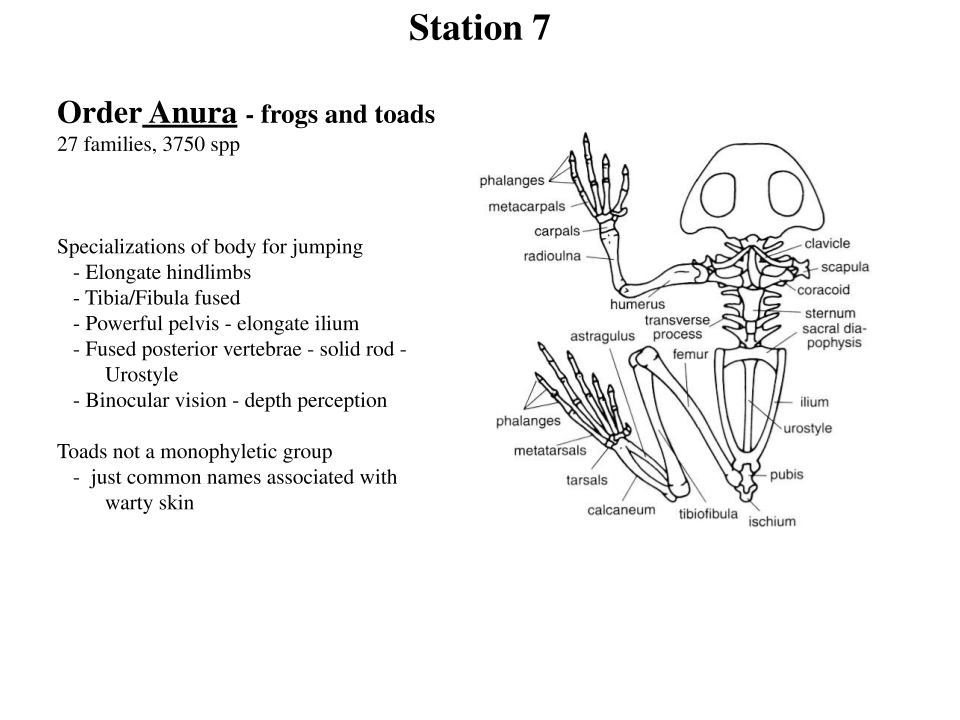
- Frogs and toads
- 27 families, 3750 spp
- Specializations of body for jumping
- Elongate hindlimbs
- Tibia/Fibula fused
- Powerful pelvis – elongate ilium
- Fused posterior vertebrae – solid rod – Urostyle
- Binocular vision – depth perception
- Toads not a monophyletic group
- Just common names associated with warty skin
- Name the Order of Amphibians that contain the frogs and toads.
- Describe important alterations to the axial skeleton (Urostyle, illium, vertebrae). Why do you think these alterations have occurred?
- Describe alterations to hindlimbs related to jumping.
- What alterations to sensory structures in anurans might be related to jumping?
- Describe the current thinking on the origin of frogs (major ancestral group).
Station 8: Scaphiopodidae
- Spadefoot Toads
- Taxonomists have split American spadefoot toads (Scaphiopodidae) from European spadefoot toads (Pelobatidae)
- Cat-like eyes with vertical pupils
- Sharp-edge spade on each hind foot
- No parotoid glands
- Poison glands near head
- Relatively smooth skin
- Breed in temporary pools or slow streams
- Dry periods spent in aestivation
- Torpor in self-made burrows or mammal burrows to avoid heat/dry
- Use spade feet to dig
- Spea hammondii – Western Spade-foot Toad
- Recently changed from genus Scaphiophus
- What is the common Scaphiopodid species (and common name for this group) found in our part of the country.
- What external structure distinguishes this group (Provides name) and what is used for?
- What is aestivation and what does it have to do with these toads? (Ask if uncertain)
Station 9: Bufonidae
- True toads
- Large family (about 300 spp)
- Chunky, short-legged
- Classic toad-like warty skin
- Large parotoid glands – secrete white toxin
- Lack teeth
- Occur in wide range of habitats
- Genus Anaxyrus
- Formerly Bufo
- Western Toad – Anaxyrus boreas
- Yosemite Toad – Anaxyrus canorus
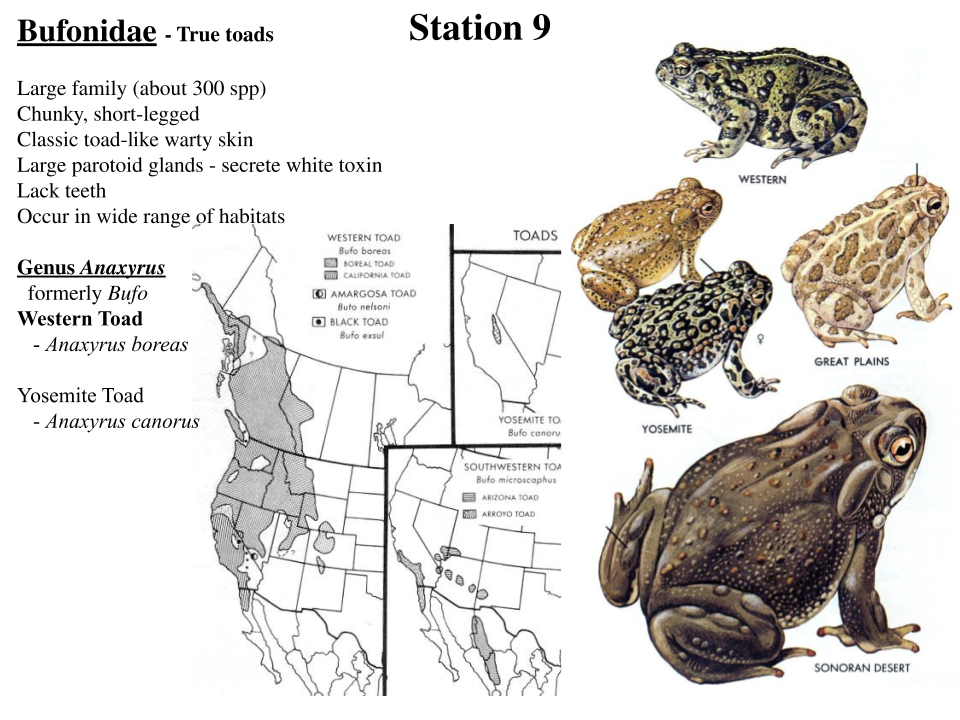
- Why are the bufonids considered the “true toads”?
- What external gland is notable in bufonids and how are they used ?(think glandularly)
- Name a genus of bufonids found in the western US.
- Name species of bufonid found in Sonoma County.
Station 10: Hylidae
- Tree Frogs and Allies
- Large family (about 600 spp)
- Slim waist, long legs, relatively small
- Many arboreal species with well developed toe pads
- Extensive vocalization during breeding season
- Extremely variable in coloration
- Pseudacris/Hyliola regilla – Pacific Tree Frog
- Genetic study (2006) proposes three species, however, study had very poor sampling
- Better data with better markers still needed
- Awaiting definitive study with nuclear molecular loci
From: http://www.californiaherps.com/frogs/pages/p.regilla.html
| The 2017 SSAR Herpetological Circular No. 43 (scientific and standard English names of amphibians and reptiles of North America north of Mexico) comments that the three species may once again be regarded as only one species, Pseudacris regilla: “Barrow et al. (2014, Mol. Phylogenet. Evol. 75: 78–900) suggested that the distinction of P. hypochondriaca and P. sierra, drawn on the basis of mtDNA, was not supported by nDNA analysis. This suggests that this taxon will ultimately be included in the synonymy of Pseudacris regilla.” Genus Hyliola In a paper published April 2016 * William E. Duellman, Angela B. Marion & S. Blair Hedges present a new phylogenetic tree of hylid frogs (Family Hylidae Rafinesque, 1815) that consists of three families, nine subfamilies, and six resurrected generic names and five new generic names. The family Hylidae contains 7 subfamiles, based on molecular information, not necessarily morphologic characters. Using this tree, the four hylid species found in California become part of the subfamily Acridinae (Acridinae Mivart, 1869) which contains two genera, Pseudacris, and Hyliola (Hyliola Mocquard, 1899.) Our treefrogs (formerly placed in the genus Pseudacris) are placed in the genus Hyliola: Hyliola cadaverina (Cope), Hyliola hypochondriaca (Hallowell), Hyliola regilla (Baird and Girard) & Hyliola sierra (Jameson, Mackey, and Richmond.) * William E. Duellman, Angela B. Marion & S. Blair Hedges. Phylogenetics, classification, and biogeography of the treefrogs (Amphibia: Anura: Arboranae) Zootaxa 4104 (1): 001–109 http://www.mapress.com/j/zt/ Copyright © 2016 Magnolia Press. |
| Alternate and Previous Names (Synonyms) The Generic name of this species was changed from Hyla (Treefrogs) to Pseudacris (Chorus Frogs). This creates confusion when some continue to use Treefrog as I do here, (along with the SSAR and the CNAH) because it has been used for many years, while others use Chorus Frog, which is actually more accurate.(See comments on the use of yet another new genus Hyliola, directly above.) Hyliola regilla (Duellman, Marion, & Hedges 2016) Pseudacris regilla – Pacific Chorus Frog (Pacific Treefrog) (Stebbins & McGinnis 2012 & 2018) Hyla regilla – Pacific Treefrog (Stebbins 1966, 1985) Hyla regilla – Pacific Tree-Frog (Stebbins 1954) Hyla regilla – Pacific Tree Frog (Pacific Tree Toad, Pacific Hyla, Wood Frog, Pacific Coast Tree Toad) (Wright & Wright 1949) Hyla regilla – Pacific Tree-toad (Storer 1925) Hyla curta (Van Denburgh 1905) Hyla scapularis (Hallowell 1854) Hyla nebulosa (Hallowell 1854) Hyla regilla (Baird & Girard 1852) |
- Name the species (and common name) found commonly locally.
- What external features would you note in order to recognize tree frogs specimens. What function might these features serve?
- Why are we not investing heavily in the current species name for this organism?
Station 11: Ranidae
- True Frogs
- Large family (over 600 spp)
- Slim waist, long legs, smooth-sinned jumpers
- Webbed hind feet
- Often dorsolateral folds (ridges) from behind eyes to lower back
- Often difficult to identify
- Genus Rana * Local species
- California Red-legged Frog – Rana draytonii*
- Northern Red-legged Frog – Rana aurora
- Foothill Yellow-legged Frog – Rana boylii*
- Mountain Yellow-legged Frog – Rana muscosa
- Bullfrog – Formerly Rana catesbiena, now Lithobates catesbeianus* (non-native)
- What external characteristics are likely to help you identify a ranid frog?
- What is the genus of ranid frog commonly found in the western US?
- Name the four species found locally. (Which are considered native?)
- Which species should NOT be handled if encountered? Why?
- Which species are often purposely killed when found in the western U.S.? Why?
Station 12: Gymnophiona
- Caecilians
- Legless
- Eyeless
- Eyes covered by skin or bone
- Some no eyes at all
- Burrowing or aquatic
- Dermal folds encircle body
- Some spp have patches of scales
- Tentacles used as sensory organs
- Found in Tropics
- What morphological characteristics distinguish the Caecilians?
- What is the name of this order? What do the root words mean?
- In what sort of environment are these species found?
- How do Caecilian origins differ from those of salamanders and frogs? (see Phylogeny from Station 1)
Review
- List the species of Amphibians (species name and common name) profiled in today’s lab that are found in Sonoma County, based on the distribution maps shown above.
